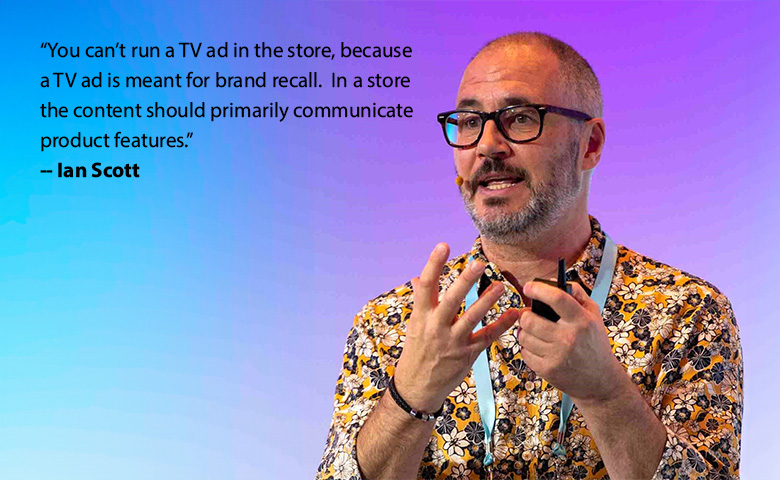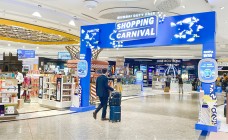“Don’t profile the shoppers, profile the reason they are shopping!”
By N Jayalakshmi | March 18, 2024
In this freewheeling conversation with Retail4Growth, UK based Retail Consultant Ian Scott, rated as one of the Top 100 Retail Influencers by Retail Rethink, and who works with some of the leading retail brands, shares his observations on what it takes for retailers to navigate the space of constantly evolving shoppers and the newly unfolding customer touchpoints.

What is the biggest change you see when it comes to the way brands are looking at their store spaces?
More and more retailers are realising that 75% of their growth still happens at the physical store, despite the digital spike we saw during the pandemic. In fact, in markets like Europe, the share of digital in retail has dropped back to pre-Covid days. So essentially, I am seeing the emergence of what I call ‘symbiotic retail’- where digital channels merge with the store space and all of them work in unison rather than as disparate options.
In your observation what is the most common mistake that retailers make when it comes to investing in their digital touchpoints in the stores?
The most common mistake I see is in terms of how retailers use content on their digital media (retail media), in the stores. This is increasingly being seen as a promising avenue and many of them are very excited about the technology. But the issue is that they are not focusing enough on the content. You can’t run a TV ad in the store, because a TV ad is meant for brand recall. In a store the content should primarily communicate product features. The other common challenge is the disconnect between browsing and buying when it comes to digital interfaces in the store. Very often shoppers are able to browse online from the store, but are not able to buy the same product there and this causes disconnect in the whole experience.
Perhaps many retailers are still in the learning curve when it comes to merging their digital and physical spaces?
Absolutely! Very often digital and store development are siloed operations with different KPIs and agenda. This is especially true in the case of legacy retailers, who may be slower in adapting to the demands of an omnichannel environment. It is also why there are often inconsistencies in the brand messaging or product pricing between the online and offline channels, and that can really put off customers.
So may be, it is time for retail organisations to relook their structure and ensure that all departments work in sync?
Yes, I agree. For example, you could have the finance, store development and the marketing departments working closely together with a common goal. This is especially important to ensure a good customer experience. Remember, today’s customers are very well informed; gone are the days when you could influence them easily. Therefore, the cost of getting it wrong is also very high today because customers can be very vocal with their complaints on social media channels, especially when they are dissatisfied with the service they encounter in the store.
The other big challenge for retailers today seems to be measuring returns from their investments in digital touchpoints and front-end technologies, isn’t it?
Yes, it is actually very hard because it is data driven. In the online space it is easy to gather data as shoppers leave their digital footprint all over, so you can gather a lot of insights with regard to their shopping patterns. But the challenge lies in cross fertilizing those insights with the physical space. Also, the fact is that even if you could gather data through cameras, mobile phones etc., it would still be challenging to correlate the analog and digital data because of privacy issues. But then, data is just a pile of meaningless numbers if you don’t interpret it, and more importantly, act on it. So this is a big challenge.
Finally, how do you think the entire eco-system, including retailers, store designers, suppliers and other partners, can approach the challenge of catering to an increasingly phygital environment?
I think this is where the role of data driven insights becomes very important and the need for insights teams and design teams to work closely together so as to be able to apply the learnings and make things better in the store space. But of course, the trick lies in balancing data driven insights with the spontaneous creativity that visual merchandisers and store designers come up with, to make sure every store looks different.
Also, shoppers behave differently at different times based on their shopping missions and other factors. So, it is very important to understand their browsing and buying patterns. Like I keep telling everyone: You shouldn’t profile the shoppers, you should profile the reason they are shopping. Of course, that’s not easy, as a lot depends on how you gather shopper insights. As David Ogilvy famously said, “The trouble with market research is that people don't think what they feel, they don't say what they think and they don't do what they say.” So merely relying on data gathered from surveys will not help. What is needed is a close understanding of shopper behaviour gathered through observation-led research.
It is also very critical to take into account the human factor, while adapting to the digital dynamics and to empower store staff to engage better with their customers for best results. End of the day, people come to the store as social beings. So while technologies like AI are very exciting and can be utilised in store functions for better results, they cannot replace humans.









Comments